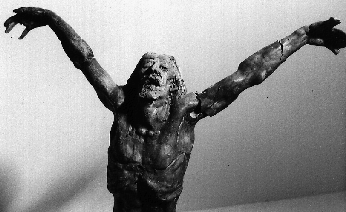"The Hunger Artist"
Summary

Interpretation
"A Hunger Artist" can be interpreted in many ways. In this story the hunger artist creates art through his own medium, fasting, just as artists of today express themselves through their own forms of art. Many of the problems which the hunger artist faces are also parallel to problems of today's artists. "A Hunger Artist" also shows the dual natures of humankind, the conflict between the spiritual aspect of the self and the physical aspect. There are also many religious parallels within the story, from both Christian and a Jewish perspectives. "A Hunger Artist" can be viewed in many different ways.
"A Hunger Artist" presents a view of the modern artist in society. The hunger artist is separated from society to be gawked and stared at, yet never really understood. The hunger artist lives only to perform his art, his way of expressing himself, but his audience never quite understands him. The hunger artist must fast, that is what he does, it is in his nature, just as it is in the nature of any artist to create. Before he dies the hunger artist says, "I have to fast I couldn't help it . . . because I couldn't find the food I liked. If I had found it, believe me, I should have made no fuss and stuffed myself like you or anyone else" (Kafka 278). The hunger artist could not find anything but his art to satisfy him, he could only fast. The modern artist must find his or her own way of satisfying his or her self, an artist must create.
The dual nature of Man is a prominent theme within "A Hunger Artist." The hunger artist is artist is concened with the spirtitual aspect of life. He does not eat or satisfy his natural cravings for food. The panther in the story represents the physical nature of Man. The panther is "furnished almost to the bursting point with all that it needed" (Kafka 278). The panther is healthy and enjoys life, while the hunger artist is deprived of his needs and only concentrates on his need for psychological fulfillment. In the end, the hunger artist is forgotten and replaced by the panther. The spectators forget about their spirits and accept only their physical needs.
Christian and Jewish ideas can be seen within "A Hunger Artist." The hunger artist can be seen as a Christ figure. He sacrifices himself for the public who watches him. In one scene "the impresario came forward, without a word . . . lifted [the hunger artist's] arms in the air above the artist, as if inviting Heaven to look down upon this creature here in the straw, this suffering martyr" (Kafka 274). This scene reminds one of Jesus on the cross, acting as a martyr to save the souls of humankind. The hunger artist, in his cage, is saving the souls of his spectators from their sin of dehumanizing people they do not understand. The artist's arms are stretched in the shape of a cross and he is being publicly displayed in front of his followers, just as Jesus was displayed during the crucifiction.
The Jewish viewpoint gives a different interpretation of the story. From the Jewish point of view, the panther is Jesus. The hunger artist represents a kind of spiritual freedom, yet he is replaced by the panther, a physical being. The spiritual martyr, or God, is replaced by the physical martyr, Jesus Christ. This ridicules the Christian need for strictly physical aspects of life.
"A Hunger Artist" is filled with metaphors and different perspectives in which to interpret the story. The work is versatile in its interpretations because of its universiality. The conflicts of the hunger artist can be applied to many different struggles, spiritual and natural. These interpretions are just a few of the many.
Return to Biography Page.